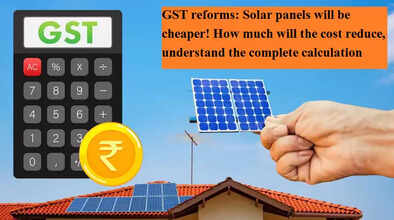GST reforms: Solar panels will be cheaper! How much will the cost reduce, understand the complete calculation

New Delhi, September 8, 2025 – The government has taken a major step to promote renewable energy adoption in India. At its 56th GST Council meeting, the tax rate on solar panels, solar cookers, and several other clean energy products has been reduced from 12% to just 5%. The move is expected to make eco-friendly solutions more affordable for households and businesses while boosting India’s climate goals. The new rates will be effective from September 22, 2025.
Which Items Will Now Attract Lower GST?
The GST Council’s decision covers a wide range of renewable energy and clean-tech products:
-
Solar panels, solar cookers, solar lanterns, and solar water heaters
-
Photovoltaic cells and solar power generators
-
Windmills, tidal energy devices, and waste-to-energy plants
-
Hydrogen fuel-cell-powered vehicles
All of these items, which earlier attracted a 12% GST, will now be taxed at just 5%.
How Much Will Consumers Save?
Lowering GST directly reduces the upfront cost of installing clean energy systems. For example:
-
A solar power system worth ₹80,000 earlier attracted 12% GST, adding ₹9,600 in tax. The total cost was ₹89,600.
-
Under the new 5% GST rate, the tax will be only ₹4,000, making the total cost ₹84,000.
-
This translates into an immediate saving of ₹5,600 for consumers.
However, experts caution that the benefit will only reach end-users if solar companies pass on the full tax reduction to buyers.
Why This Matters for India’s Green Goals
The government has repeatedly emphasized its commitment to making clean energy solutions affordable and accessible. By lowering GST on solar, wind, and hydrogen-based products, the aim is to encourage more households and businesses to adopt renewable power.
This reform not only supports India’s climate commitments but also strengthens the country’s push toward energy independence and sustainable growth.
The Challenge of Inverted Duty Structure
While the reduction is good news for consumers, it has raised concerns for manufacturers. Clean energy products face what is known as an inverted duty structure—where raw materials are taxed at higher rates than finished goods.
This often leaves companies with excess input tax credit (ITC) stuck in the system. The government has admitted that the shift to 5% GST may worsen this issue but has assured that refund mechanisms will be streamlined to maintain smooth cash flow for businesses.
A Simpler GST Framework for Everyday Goods
Beyond renewable energy, the GST Council also announced a simplified tax structure. The number of GST slabs has been reduced from four to just two:
-
5% slab: Covering essential and clean energy items.
-
18% slab: Covering a wide range of goods and services.
Luxury and sin goods will continue to attract a higher rate of 40%.
This rationalization is expected to make daily essentials like butter, ghee, shampoo, as well as electronics such as air conditioners and televisions, more affordable for middle-class households.
Key Takeaways
-
GST on solar panels, cookers, and other clean energy items cut from 12% to 5%.
-
Consumers can save thousands on solar installations—for instance, ₹5,600 on an ₹80,000 system.
-
The move aligns with India’s climate and renewable energy targets.
-
Manufacturers may face challenges due to the inverted duty structure, but refund systems are being improved.
-
GST framework simplified to two main slabs (5% and 18%), reducing complexity.
Conclusion: By lowering GST rates on clean energy products, the government has taken a significant step toward making renewable energy affordable, accessible, and attractive for millions of Indians. While consumers stand to benefit immediately, smooth execution and fair pricing by companies will be critical for realizing the full potential of this reform.

